Research Proposal about Analysis on Management
VerifiedAdded on 2022/10/06
|11
|3261
|15
Assignment
AI Summary
Contribute Materials
Your contribution can guide someone’s learning journey. Share your
documents today.
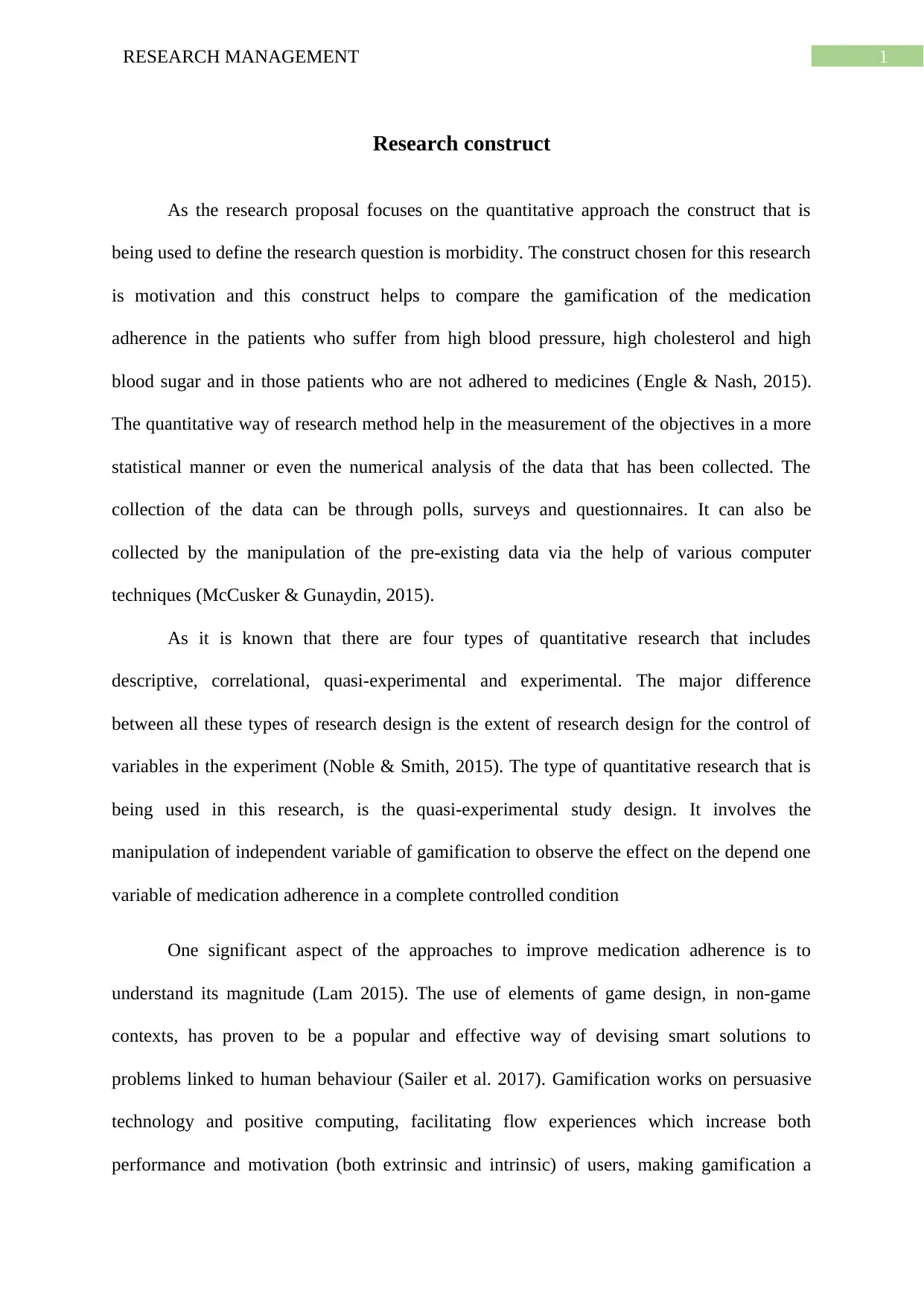
1RESEARCH MANAGEMENT
Research construct
As the research proposal focuses on the quantitative approach the construct that is
being used to define the research question is morbidity. The construct chosen for this research
is motivation and this construct helps to compare the gamification of the medication
adherence in the patients who suffer from high blood pressure, high cholesterol and high
blood sugar and in those patients who are not adhered to medicines (Engle & Nash, 2015).
The quantitative way of research method help in the measurement of the objectives in a more
statistical manner or even the numerical analysis of the data that has been collected. The
collection of the data can be through polls, surveys and questionnaires. It can also be
collected by the manipulation of the pre-existing data via the help of various computer
techniques (McCusker & Gunaydin, 2015).
As it is known that there are four types of quantitative research that includes
descriptive, correlational, quasi-experimental and experimental. The major difference
between all these types of research design is the extent of research design for the control of
variables in the experiment (Noble & Smith, 2015). The type of quantitative research that is
being used in this research, is the quasi-experimental study design. It involves the
manipulation of independent variable of gamification to observe the effect on the depend one
variable of medication adherence in a complete controlled condition
One significant aspect of the approaches to improve medication adherence is to
understand its magnitude (Lam 2015). The use of elements of game design, in non-game
contexts, has proven to be a popular and effective way of devising smart solutions to
problems linked to human behaviour (Sailer et al. 2017). Gamification works on persuasive
technology and positive computing, facilitating flow experiences which increase both
performance and motivation (both extrinsic and intrinsic) of users, making gamification a
Research construct
As the research proposal focuses on the quantitative approach the construct that is
being used to define the research question is morbidity. The construct chosen for this research
is motivation and this construct helps to compare the gamification of the medication
adherence in the patients who suffer from high blood pressure, high cholesterol and high
blood sugar and in those patients who are not adhered to medicines (Engle & Nash, 2015).
The quantitative way of research method help in the measurement of the objectives in a more
statistical manner or even the numerical analysis of the data that has been collected. The
collection of the data can be through polls, surveys and questionnaires. It can also be
collected by the manipulation of the pre-existing data via the help of various computer
techniques (McCusker & Gunaydin, 2015).
As it is known that there are four types of quantitative research that includes
descriptive, correlational, quasi-experimental and experimental. The major difference
between all these types of research design is the extent of research design for the control of
variables in the experiment (Noble & Smith, 2015). The type of quantitative research that is
being used in this research, is the quasi-experimental study design. It involves the
manipulation of independent variable of gamification to observe the effect on the depend one
variable of medication adherence in a complete controlled condition
One significant aspect of the approaches to improve medication adherence is to
understand its magnitude (Lam 2015). The use of elements of game design, in non-game
contexts, has proven to be a popular and effective way of devising smart solutions to
problems linked to human behaviour (Sailer et al. 2017). Gamification works on persuasive
technology and positive computing, facilitating flow experiences which increase both
performance and motivation (both extrinsic and intrinsic) of users, making gamification a
Secure Best Marks with AI Grader
Need help grading? Try our AI Grader for instant feedback on your assignments.
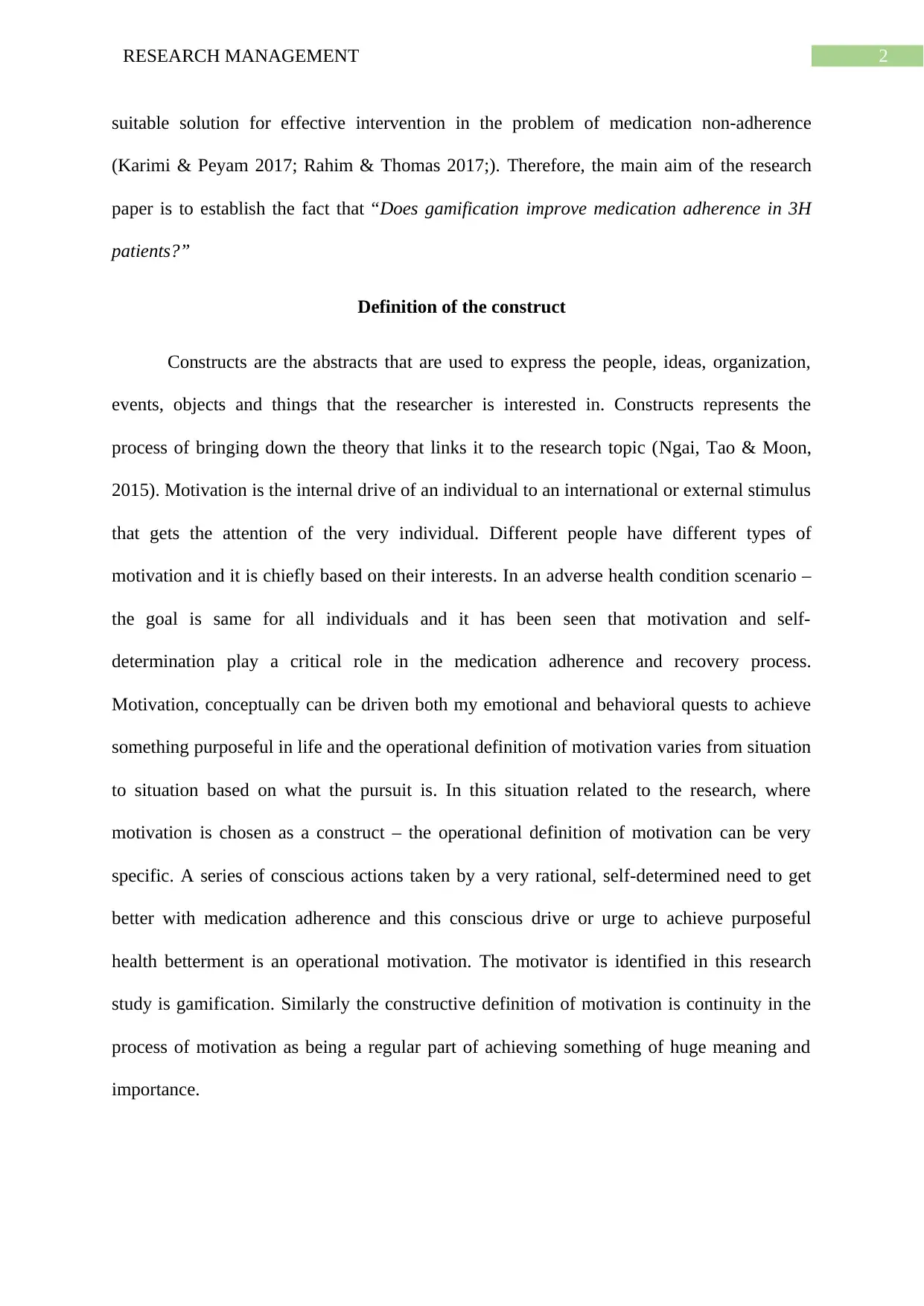
2RESEARCH MANAGEMENT
suitable solution for effective intervention in the problem of medication non-adherence
(Karimi & Peyam 2017; Rahim & Thomas 2017;). Therefore, the main aim of the research
paper is to establish the fact that “Does gamification improve medication adherence in 3H
patients?”
Definition of the construct
Constructs are the abstracts that are used to express the people, ideas, organization,
events, objects and things that the researcher is interested in. Constructs represents the
process of bringing down the theory that links it to the research topic (Ngai, Tao & Moon,
2015). Motivation is the internal drive of an individual to an international or external stimulus
that gets the attention of the very individual. Different people have different types of
motivation and it is chiefly based on their interests. In an adverse health condition scenario –
the goal is same for all individuals and it has been seen that motivation and self-
determination play a critical role in the medication adherence and recovery process.
Motivation, conceptually can be driven both my emotional and behavioral quests to achieve
something purposeful in life and the operational definition of motivation varies from situation
to situation based on what the pursuit is. In this situation related to the research, where
motivation is chosen as a construct – the operational definition of motivation can be very
specific. A series of conscious actions taken by a very rational, self-determined need to get
better with medication adherence and this conscious drive or urge to achieve purposeful
health betterment is an operational motivation. The motivator is identified in this research
study is gamification. Similarly the constructive definition of motivation is continuity in the
process of motivation as being a regular part of achieving something of huge meaning and
importance.
suitable solution for effective intervention in the problem of medication non-adherence
(Karimi & Peyam 2017; Rahim & Thomas 2017;). Therefore, the main aim of the research
paper is to establish the fact that “Does gamification improve medication adherence in 3H
patients?”
Definition of the construct
Constructs are the abstracts that are used to express the people, ideas, organization,
events, objects and things that the researcher is interested in. Constructs represents the
process of bringing down the theory that links it to the research topic (Ngai, Tao & Moon,
2015). Motivation is the internal drive of an individual to an international or external stimulus
that gets the attention of the very individual. Different people have different types of
motivation and it is chiefly based on their interests. In an adverse health condition scenario –
the goal is same for all individuals and it has been seen that motivation and self-
determination play a critical role in the medication adherence and recovery process.
Motivation, conceptually can be driven both my emotional and behavioral quests to achieve
something purposeful in life and the operational definition of motivation varies from situation
to situation based on what the pursuit is. In this situation related to the research, where
motivation is chosen as a construct – the operational definition of motivation can be very
specific. A series of conscious actions taken by a very rational, self-determined need to get
better with medication adherence and this conscious drive or urge to achieve purposeful
health betterment is an operational motivation. The motivator is identified in this research
study is gamification. Similarly the constructive definition of motivation is continuity in the
process of motivation as being a regular part of achieving something of huge meaning and
importance.
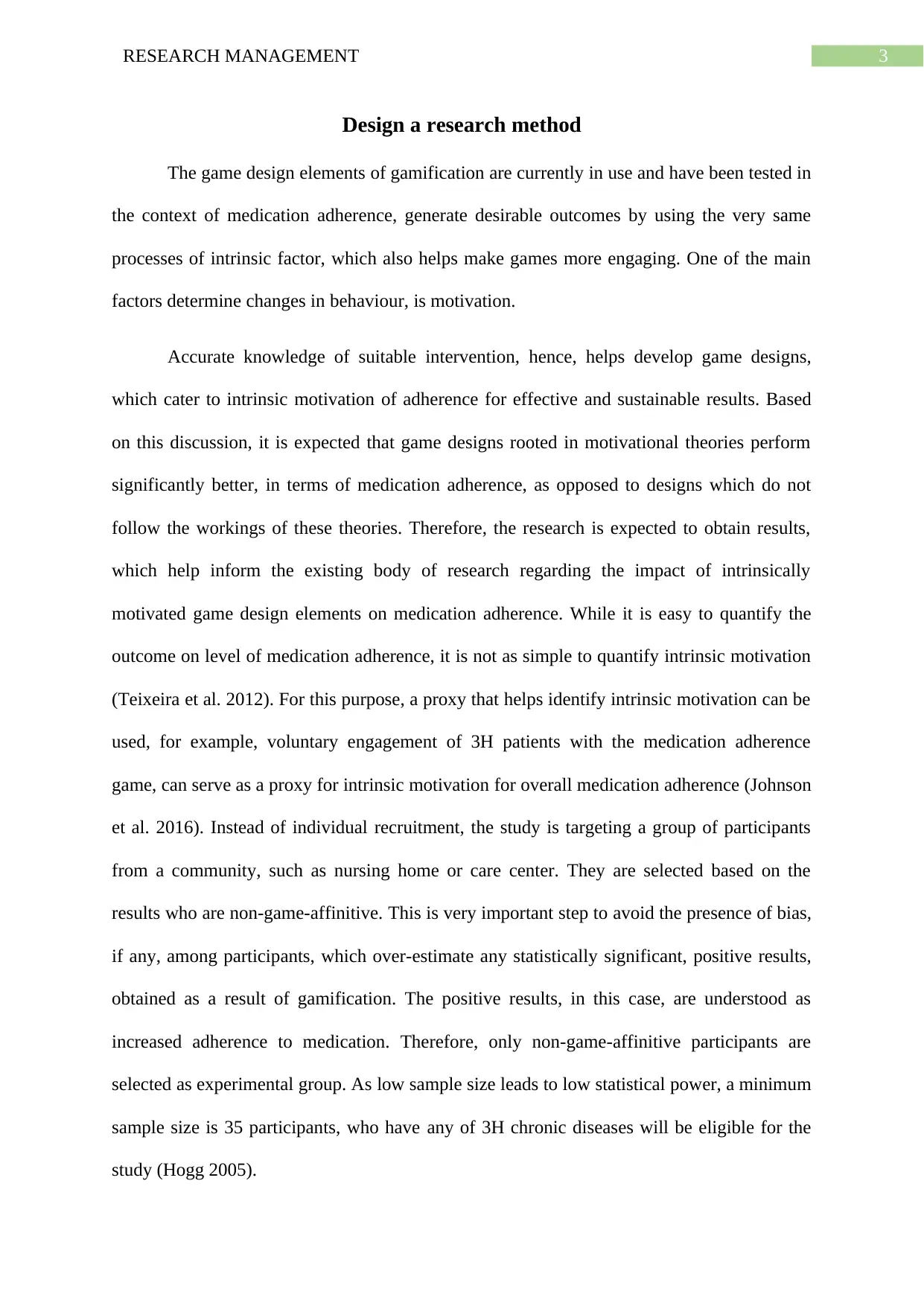
3RESEARCH MANAGEMENT
Design a research method
The game design elements of gamification are currently in use and have been tested in
the context of medication adherence, generate desirable outcomes by using the very same
processes of intrinsic factor, which also helps make games more engaging. One of the main
factors determine changes in behaviour, is motivation.
Accurate knowledge of suitable intervention, hence, helps develop game designs,
which cater to intrinsic motivation of adherence for effective and sustainable results. Based
on this discussion, it is expected that game designs rooted in motivational theories perform
significantly better, in terms of medication adherence, as opposed to designs which do not
follow the workings of these theories. Therefore, the research is expected to obtain results,
which help inform the existing body of research regarding the impact of intrinsically
motivated game design elements on medication adherence. While it is easy to quantify the
outcome on level of medication adherence, it is not as simple to quantify intrinsic motivation
(Teixeira et al. 2012). For this purpose, a proxy that helps identify intrinsic motivation can be
used, for example, voluntary engagement of 3H patients with the medication adherence
game, can serve as a proxy for intrinsic motivation for overall medication adherence (Johnson
et al. 2016). Instead of individual recruitment, the study is targeting a group of participants
from a community, such as nursing home or care center. They are selected based on the
results who are non-game-affinitive. This is very important step to avoid the presence of bias,
if any, among participants, which over-estimate any statistically significant, positive results,
obtained as a result of gamification. The positive results, in this case, are understood as
increased adherence to medication. Therefore, only non-game-affinitive participants are
selected as experimental group. As low sample size leads to low statistical power, a minimum
sample size is 35 participants, who have any of 3H chronic diseases will be eligible for the
study (Hogg 2005).
Design a research method
The game design elements of gamification are currently in use and have been tested in
the context of medication adherence, generate desirable outcomes by using the very same
processes of intrinsic factor, which also helps make games more engaging. One of the main
factors determine changes in behaviour, is motivation.
Accurate knowledge of suitable intervention, hence, helps develop game designs,
which cater to intrinsic motivation of adherence for effective and sustainable results. Based
on this discussion, it is expected that game designs rooted in motivational theories perform
significantly better, in terms of medication adherence, as opposed to designs which do not
follow the workings of these theories. Therefore, the research is expected to obtain results,
which help inform the existing body of research regarding the impact of intrinsically
motivated game design elements on medication adherence. While it is easy to quantify the
outcome on level of medication adherence, it is not as simple to quantify intrinsic motivation
(Teixeira et al. 2012). For this purpose, a proxy that helps identify intrinsic motivation can be
used, for example, voluntary engagement of 3H patients with the medication adherence
game, can serve as a proxy for intrinsic motivation for overall medication adherence (Johnson
et al. 2016). Instead of individual recruitment, the study is targeting a group of participants
from a community, such as nursing home or care center. They are selected based on the
results who are non-game-affinitive. This is very important step to avoid the presence of bias,
if any, among participants, which over-estimate any statistically significant, positive results,
obtained as a result of gamification. The positive results, in this case, are understood as
increased adherence to medication. Therefore, only non-game-affinitive participants are
selected as experimental group. As low sample size leads to low statistical power, a minimum
sample size is 35 participants, who have any of 3H chronic diseases will be eligible for the
study (Hogg 2005).
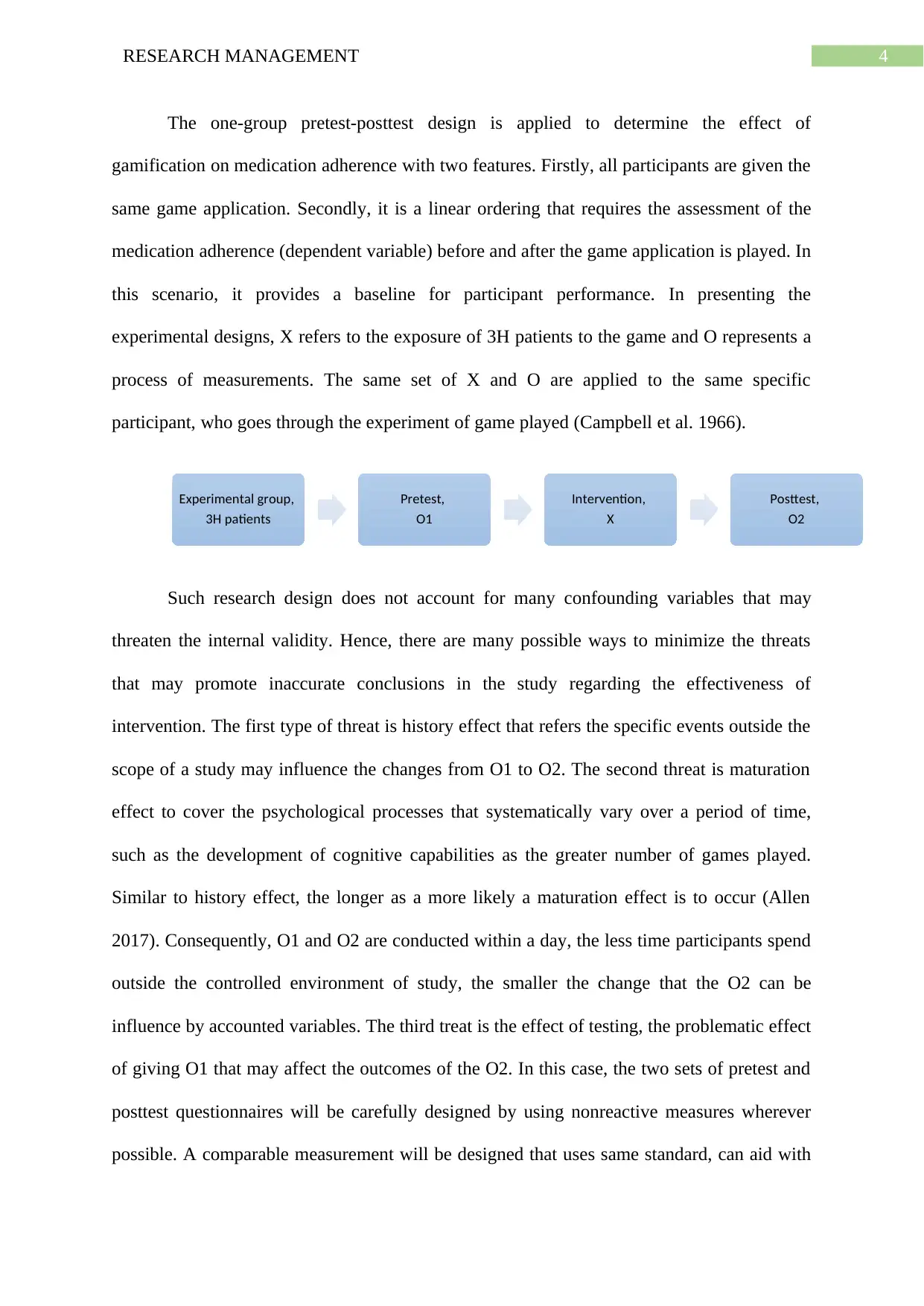
4RESEARCH MANAGEMENT
The one-group pretest-posttest design is applied to determine the effect of
gamification on medication adherence with two features. Firstly, all participants are given the
same game application. Secondly, it is a linear ordering that requires the assessment of the
medication adherence (dependent variable) before and after the game application is played. In
this scenario, it provides a baseline for participant performance. In presenting the
experimental designs, X refers to the exposure of 3H patients to the game and O represents a
process of measurements. The same set of X and O are applied to the same specific
participant, who goes through the experiment of game played (Campbell et al. 1966).
Such research design does not account for many confounding variables that may
threaten the internal validity. Hence, there are many possible ways to minimize the threats
that may promote inaccurate conclusions in the study regarding the effectiveness of
intervention. The first type of threat is history effect that refers the specific events outside the
scope of a study may influence the changes from O1 to O2. The second threat is maturation
effect to cover the psychological processes that systematically vary over a period of time,
such as the development of cognitive capabilities as the greater number of games played.
Similar to history effect, the longer as a more likely a maturation effect is to occur (Allen
2017). Consequently, O1 and O2 are conducted within a day, the less time participants spend
outside the controlled environment of study, the smaller the change that the O2 can be
influence by accounted variables. The third treat is the effect of testing, the problematic effect
of giving O1 that may affect the outcomes of the O2. In this case, the two sets of pretest and
posttest questionnaires will be carefully designed by using nonreactive measures wherever
possible. A comparable measurement will be designed that uses same standard, can aid with
Experimental group,
3H patients
Pretest,
O1
Intervention,
X
Posttest,
O2
The one-group pretest-posttest design is applied to determine the effect of
gamification on medication adherence with two features. Firstly, all participants are given the
same game application. Secondly, it is a linear ordering that requires the assessment of the
medication adherence (dependent variable) before and after the game application is played. In
this scenario, it provides a baseline for participant performance. In presenting the
experimental designs, X refers to the exposure of 3H patients to the game and O represents a
process of measurements. The same set of X and O are applied to the same specific
participant, who goes through the experiment of game played (Campbell et al. 1966).
Such research design does not account for many confounding variables that may
threaten the internal validity. Hence, there are many possible ways to minimize the threats
that may promote inaccurate conclusions in the study regarding the effectiveness of
intervention. The first type of threat is history effect that refers the specific events outside the
scope of a study may influence the changes from O1 to O2. The second threat is maturation
effect to cover the psychological processes that systematically vary over a period of time,
such as the development of cognitive capabilities as the greater number of games played.
Similar to history effect, the longer as a more likely a maturation effect is to occur (Allen
2017). Consequently, O1 and O2 are conducted within a day, the less time participants spend
outside the controlled environment of study, the smaller the change that the O2 can be
influence by accounted variables. The third treat is the effect of testing, the problematic effect
of giving O1 that may affect the outcomes of the O2. In this case, the two sets of pretest and
posttest questionnaires will be carefully designed by using nonreactive measures wherever
possible. A comparable measurement will be designed that uses same standard, can aid with
Experimental group,
3H patients
Pretest,
O1
Intervention,
X
Posttest,
O2
Secure Best Marks with AI Grader
Need help grading? Try our AI Grader for instant feedback on your assignments.
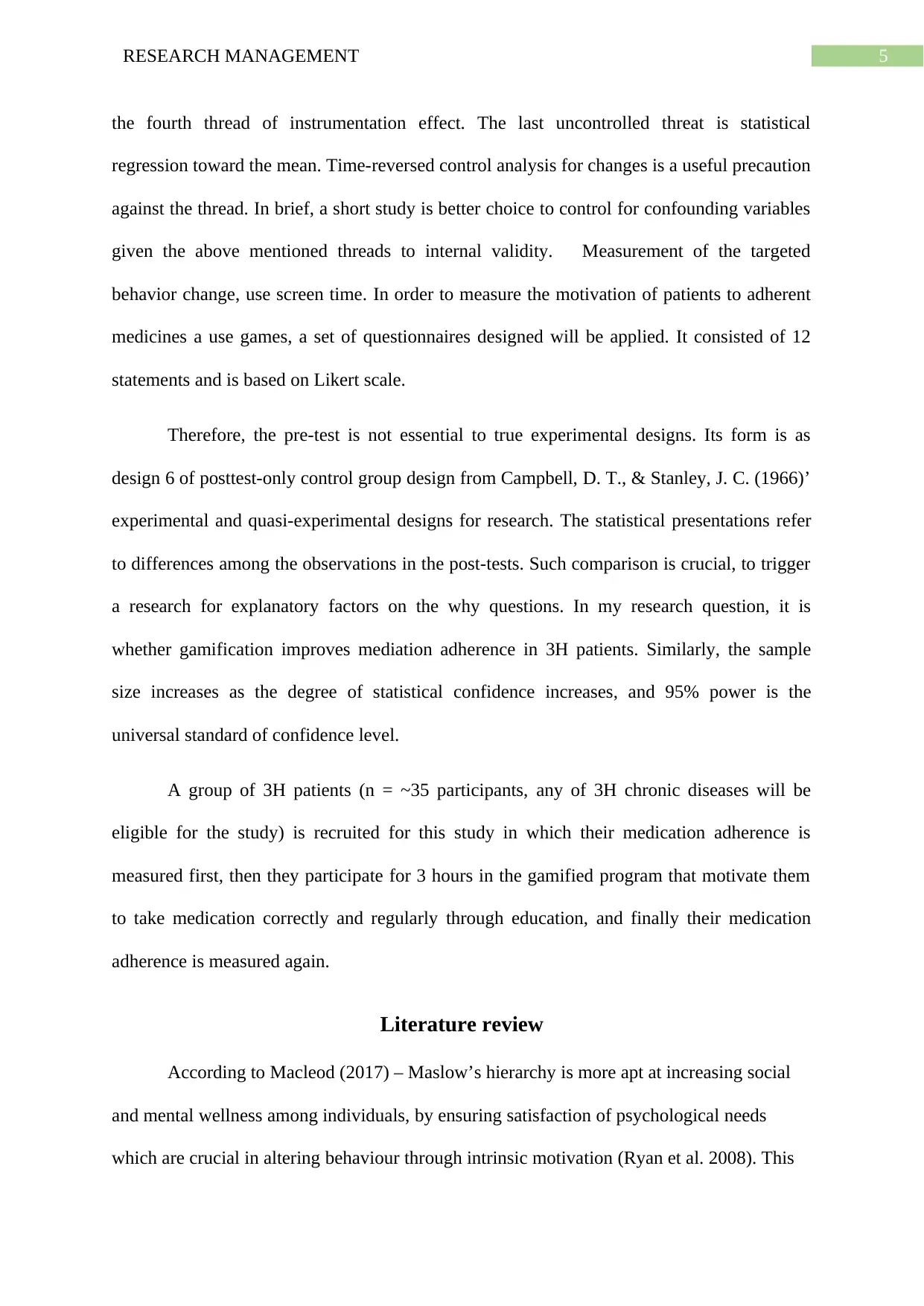
5RESEARCH MANAGEMENT
the fourth thread of instrumentation effect. The last uncontrolled threat is statistical
regression toward the mean. Time-reversed control analysis for changes is a useful precaution
against the thread. In brief, a short study is better choice to control for confounding variables
given the above mentioned threads to internal validity. Measurement of the targeted
behavior change, use screen time. In order to measure the motivation of patients to adherent
medicines a use games, a set of questionnaires designed will be applied. It consisted of 12
statements and is based on Likert scale.
Therefore, the pre-test is not essential to true experimental designs. Its form is as
design 6 of posttest-only control group design from Campbell, D. T., & Stanley, J. C. (1966)’
experimental and quasi-experimental designs for research. The statistical presentations refer
to differences among the observations in the post-tests. Such comparison is crucial, to trigger
a research for explanatory factors on the why questions. In my research question, it is
whether gamification improves mediation adherence in 3H patients. Similarly, the sample
size increases as the degree of statistical confidence increases, and 95% power is the
universal standard of confidence level.
A group of 3H patients (n = ~35 participants, any of 3H chronic diseases will be
eligible for the study) is recruited for this study in which their medication adherence is
measured first, then they participate for 3 hours in the gamified program that motivate them
to take medication correctly and regularly through education, and finally their medication
adherence is measured again.
Literature review
According to Macleod (2017) – Maslow’s hierarchy is more apt at increasing social
and mental wellness among individuals, by ensuring satisfaction of psychological needs
which are crucial in altering behaviour through intrinsic motivation (Ryan et al. 2008). This
the fourth thread of instrumentation effect. The last uncontrolled threat is statistical
regression toward the mean. Time-reversed control analysis for changes is a useful precaution
against the thread. In brief, a short study is better choice to control for confounding variables
given the above mentioned threads to internal validity. Measurement of the targeted
behavior change, use screen time. In order to measure the motivation of patients to adherent
medicines a use games, a set of questionnaires designed will be applied. It consisted of 12
statements and is based on Likert scale.
Therefore, the pre-test is not essential to true experimental designs. Its form is as
design 6 of posttest-only control group design from Campbell, D. T., & Stanley, J. C. (1966)’
experimental and quasi-experimental designs for research. The statistical presentations refer
to differences among the observations in the post-tests. Such comparison is crucial, to trigger
a research for explanatory factors on the why questions. In my research question, it is
whether gamification improves mediation adherence in 3H patients. Similarly, the sample
size increases as the degree of statistical confidence increases, and 95% power is the
universal standard of confidence level.
A group of 3H patients (n = ~35 participants, any of 3H chronic diseases will be
eligible for the study) is recruited for this study in which their medication adherence is
measured first, then they participate for 3 hours in the gamified program that motivate them
to take medication correctly and regularly through education, and finally their medication
adherence is measured again.
Literature review
According to Macleod (2017) – Maslow’s hierarchy is more apt at increasing social
and mental wellness among individuals, by ensuring satisfaction of psychological needs
which are crucial in altering behaviour through intrinsic motivation (Ryan et al. 2008). This
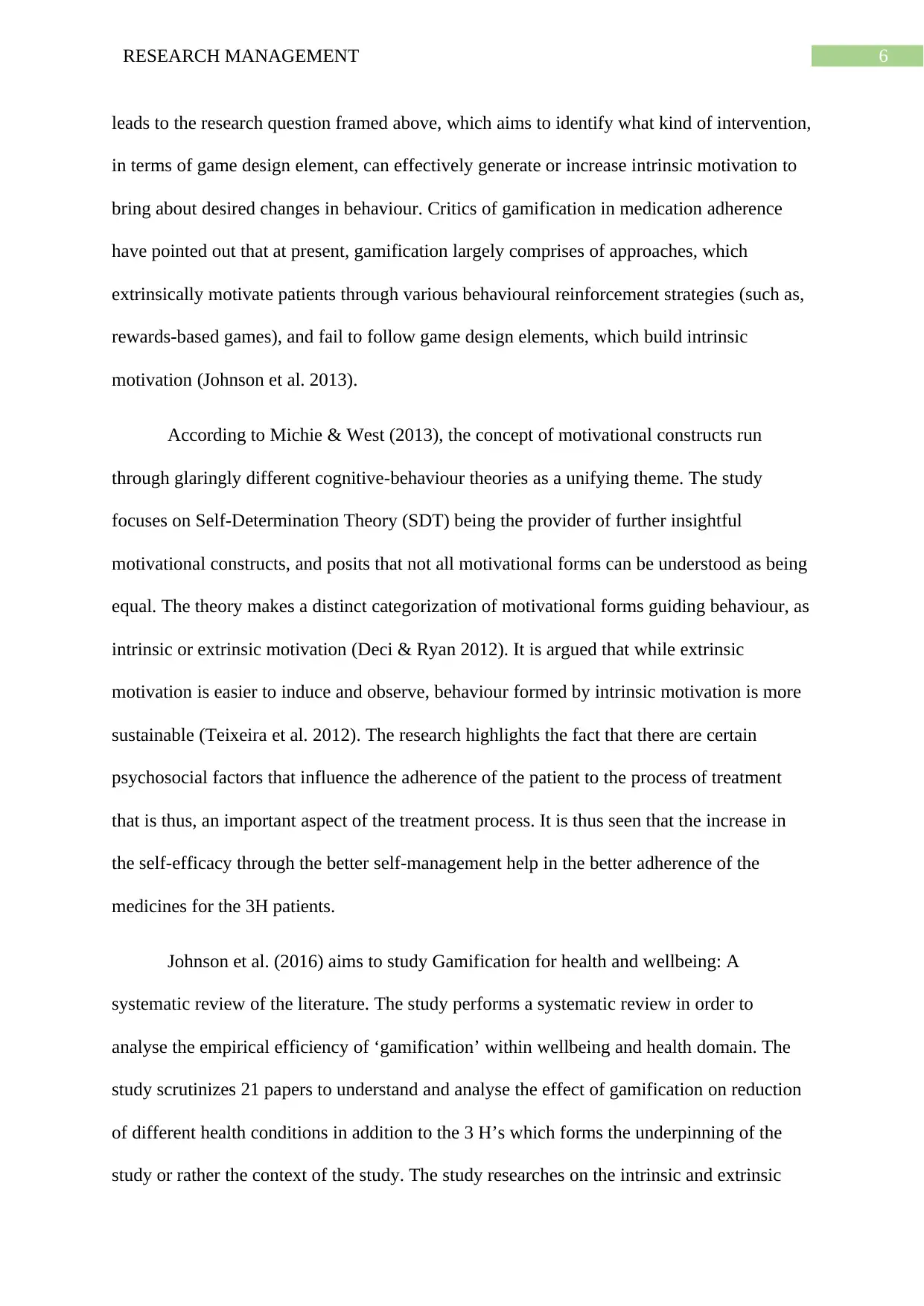
6RESEARCH MANAGEMENT
leads to the research question framed above, which aims to identify what kind of intervention,
in terms of game design element, can effectively generate or increase intrinsic motivation to
bring about desired changes in behaviour. Critics of gamification in medication adherence
have pointed out that at present, gamification largely comprises of approaches, which
extrinsically motivate patients through various behavioural reinforcement strategies (such as,
rewards-based games), and fail to follow game design elements, which build intrinsic
motivation (Johnson et al. 2013).
According to Michie & West (2013), the concept of motivational constructs run
through glaringly different cognitive-behaviour theories as a unifying theme. The study
focuses on Self-Determination Theory (SDT) being the provider of further insightful
motivational constructs, and posits that not all motivational forms can be understood as being
equal. The theory makes a distinct categorization of motivational forms guiding behaviour, as
intrinsic or extrinsic motivation (Deci & Ryan 2012). It is argued that while extrinsic
motivation is easier to induce and observe, behaviour formed by intrinsic motivation is more
sustainable (Teixeira et al. 2012). The research highlights the fact that there are certain
psychosocial factors that influence the adherence of the patient to the process of treatment
that is thus, an important aspect of the treatment process. It is thus seen that the increase in
the self-efficacy through the better self-management help in the better adherence of the
medicines for the 3H patients.
Johnson et al. (2016) aims to study Gamification for health and wellbeing: A
systematic review of the literature. The study performs a systematic review in order to
analyse the empirical efficiency of ‘gamification’ within wellbeing and health domain. The
study scrutinizes 21 papers to understand and analyse the effect of gamification on reduction
of different health conditions in addition to the 3 H’s which forms the underpinning of the
study or rather the context of the study. The study researches on the intrinsic and extrinsic
leads to the research question framed above, which aims to identify what kind of intervention,
in terms of game design element, can effectively generate or increase intrinsic motivation to
bring about desired changes in behaviour. Critics of gamification in medication adherence
have pointed out that at present, gamification largely comprises of approaches, which
extrinsically motivate patients through various behavioural reinforcement strategies (such as,
rewards-based games), and fail to follow game design elements, which build intrinsic
motivation (Johnson et al. 2013).
According to Michie & West (2013), the concept of motivational constructs run
through glaringly different cognitive-behaviour theories as a unifying theme. The study
focuses on Self-Determination Theory (SDT) being the provider of further insightful
motivational constructs, and posits that not all motivational forms can be understood as being
equal. The theory makes a distinct categorization of motivational forms guiding behaviour, as
intrinsic or extrinsic motivation (Deci & Ryan 2012). It is argued that while extrinsic
motivation is easier to induce and observe, behaviour formed by intrinsic motivation is more
sustainable (Teixeira et al. 2012). The research highlights the fact that there are certain
psychosocial factors that influence the adherence of the patient to the process of treatment
that is thus, an important aspect of the treatment process. It is thus seen that the increase in
the self-efficacy through the better self-management help in the better adherence of the
medicines for the 3H patients.
Johnson et al. (2016) aims to study Gamification for health and wellbeing: A
systematic review of the literature. The study performs a systematic review in order to
analyse the empirical efficiency of ‘gamification’ within wellbeing and health domain. The
study scrutinizes 21 papers to understand and analyse the effect of gamification on reduction
of different health conditions in addition to the 3 H’s which forms the underpinning of the
study or rather the context of the study. The study researches on the intrinsic and extrinsic
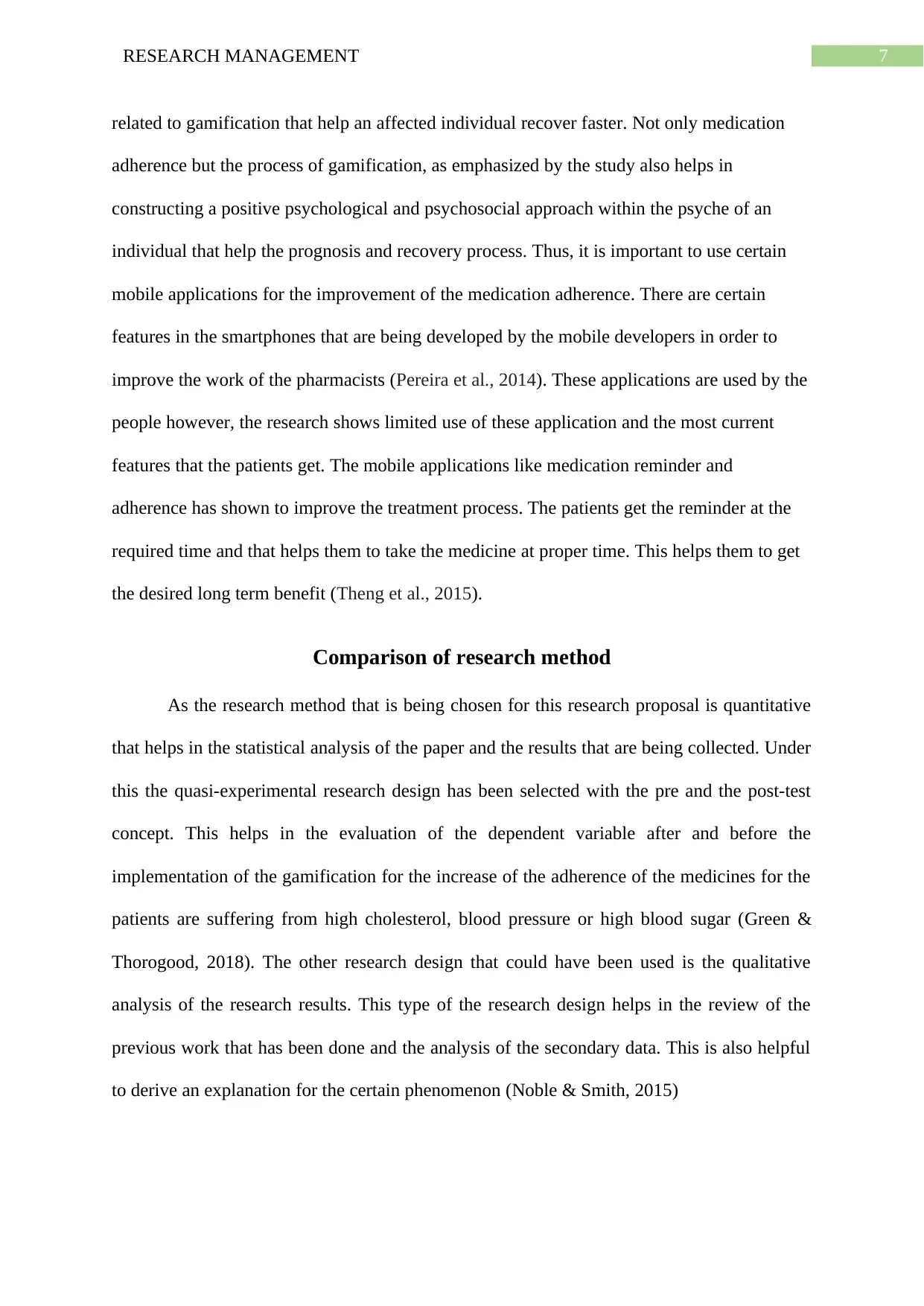
7RESEARCH MANAGEMENT
related to gamification that help an affected individual recover faster. Not only medication
adherence but the process of gamification, as emphasized by the study also helps in
constructing a positive psychological and psychosocial approach within the psyche of an
individual that help the prognosis and recovery process. Thus, it is important to use certain
mobile applications for the improvement of the medication adherence. There are certain
features in the smartphones that are being developed by the mobile developers in order to
improve the work of the pharmacists (Pereira et al., 2014). These applications are used by the
people however, the research shows limited use of these application and the most current
features that the patients get. The mobile applications like medication reminder and
adherence has shown to improve the treatment process. The patients get the reminder at the
required time and that helps them to take the medicine at proper time. This helps them to get
the desired long term benefit (Theng et al., 2015).
Comparison of research method
As the research method that is being chosen for this research proposal is quantitative
that helps in the statistical analysis of the paper and the results that are being collected. Under
this the quasi-experimental research design has been selected with the pre and the post-test
concept. This helps in the evaluation of the dependent variable after and before the
implementation of the gamification for the increase of the adherence of the medicines for the
patients are suffering from high cholesterol, blood pressure or high blood sugar (Green &
Thorogood, 2018). The other research design that could have been used is the qualitative
analysis of the research results. This type of the research design helps in the review of the
previous work that has been done and the analysis of the secondary data. This is also helpful
to derive an explanation for the certain phenomenon (Noble & Smith, 2015)
related to gamification that help an affected individual recover faster. Not only medication
adherence but the process of gamification, as emphasized by the study also helps in
constructing a positive psychological and psychosocial approach within the psyche of an
individual that help the prognosis and recovery process. Thus, it is important to use certain
mobile applications for the improvement of the medication adherence. There are certain
features in the smartphones that are being developed by the mobile developers in order to
improve the work of the pharmacists (Pereira et al., 2014). These applications are used by the
people however, the research shows limited use of these application and the most current
features that the patients get. The mobile applications like medication reminder and
adherence has shown to improve the treatment process. The patients get the reminder at the
required time and that helps them to take the medicine at proper time. This helps them to get
the desired long term benefit (Theng et al., 2015).
Comparison of research method
As the research method that is being chosen for this research proposal is quantitative
that helps in the statistical analysis of the paper and the results that are being collected. Under
this the quasi-experimental research design has been selected with the pre and the post-test
concept. This helps in the evaluation of the dependent variable after and before the
implementation of the gamification for the increase of the adherence of the medicines for the
patients are suffering from high cholesterol, blood pressure or high blood sugar (Green &
Thorogood, 2018). The other research design that could have been used is the qualitative
analysis of the research results. This type of the research design helps in the review of the
previous work that has been done and the analysis of the secondary data. This is also helpful
to derive an explanation for the certain phenomenon (Noble & Smith, 2015)
Paraphrase This Document
Need a fresh take? Get an instant paraphrase of this document with our AI Paraphraser
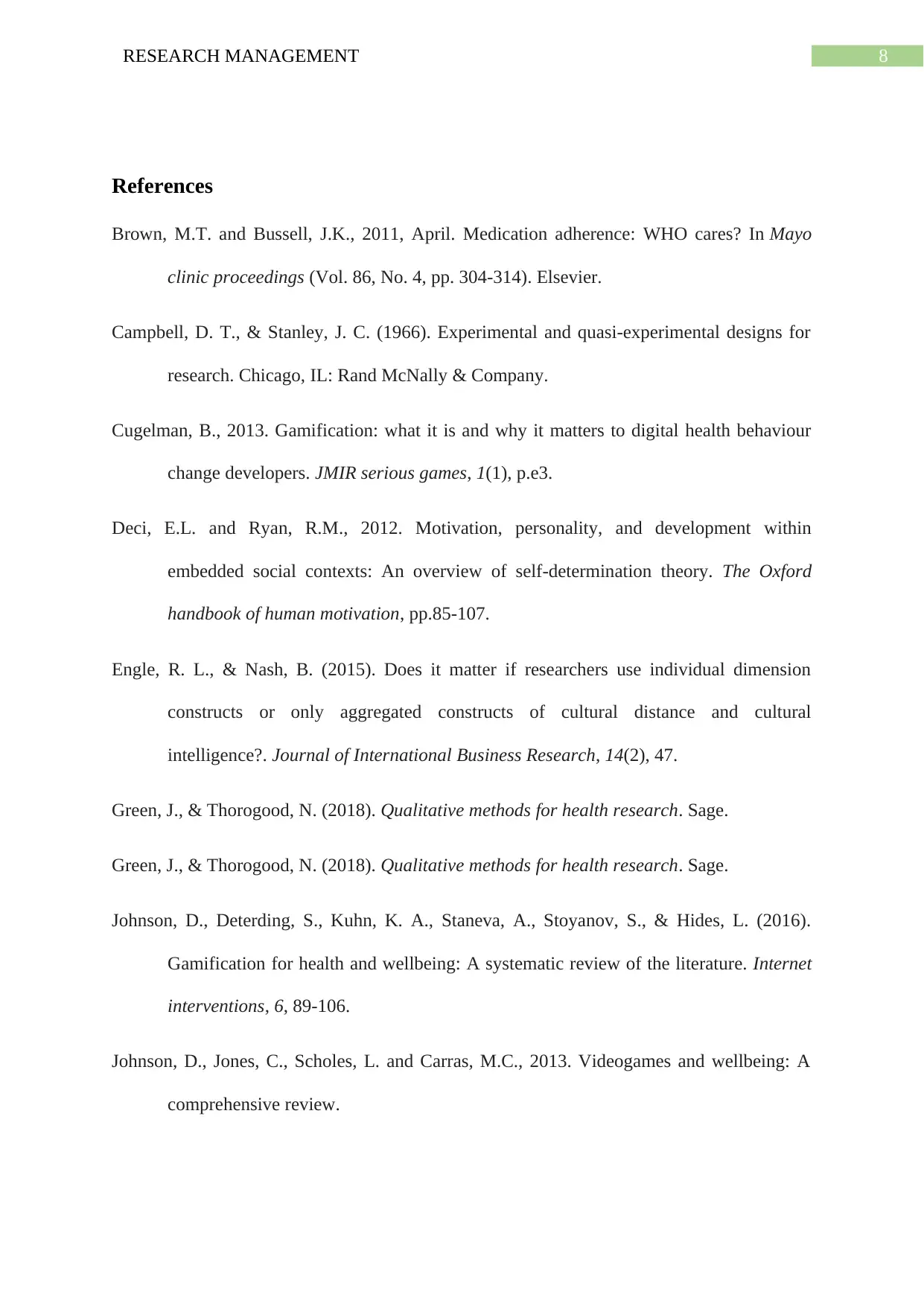
8RESEARCH MANAGEMENT
References
Brown, M.T. and Bussell, J.K., 2011, April. Medication adherence: WHO cares? In Mayo
clinic proceedings (Vol. 86, No. 4, pp. 304-314). Elsevier.
Campbell, D. T., & Stanley, J. C. (1966). Experimental and quasi-experimental designs for
research. Chicago, IL: Rand McNally & Company.
Cugelman, B., 2013. Gamification: what it is and why it matters to digital health behaviour
change developers. JMIR serious games, 1(1), p.e3.
Deci, E.L. and Ryan, R.M., 2012. Motivation, personality, and development within
embedded social contexts: An overview of self-determination theory. The Oxford
handbook of human motivation, pp.85-107.
Engle, R. L., & Nash, B. (2015). Does it matter if researchers use individual dimension
constructs or only aggregated constructs of cultural distance and cultural
intelligence?. Journal of International Business Research, 14(2), 47.
Green, J., & Thorogood, N. (2018). Qualitative methods for health research. Sage.
Green, J., & Thorogood, N. (2018). Qualitative methods for health research. Sage.
Johnson, D., Deterding, S., Kuhn, K. A., Staneva, A., Stoyanov, S., & Hides, L. (2016).
Gamification for health and wellbeing: A systematic review of the literature. Internet
interventions, 6, 89-106.
Johnson, D., Jones, C., Scholes, L. and Carras, M.C., 2013. Videogames and wellbeing: A
comprehensive review.
References
Brown, M.T. and Bussell, J.K., 2011, April. Medication adherence: WHO cares? In Mayo
clinic proceedings (Vol. 86, No. 4, pp. 304-314). Elsevier.
Campbell, D. T., & Stanley, J. C. (1966). Experimental and quasi-experimental designs for
research. Chicago, IL: Rand McNally & Company.
Cugelman, B., 2013. Gamification: what it is and why it matters to digital health behaviour
change developers. JMIR serious games, 1(1), p.e3.
Deci, E.L. and Ryan, R.M., 2012. Motivation, personality, and development within
embedded social contexts: An overview of self-determination theory. The Oxford
handbook of human motivation, pp.85-107.
Engle, R. L., & Nash, B. (2015). Does it matter if researchers use individual dimension
constructs or only aggregated constructs of cultural distance and cultural
intelligence?. Journal of International Business Research, 14(2), 47.
Green, J., & Thorogood, N. (2018). Qualitative methods for health research. Sage.
Green, J., & Thorogood, N. (2018). Qualitative methods for health research. Sage.
Johnson, D., Deterding, S., Kuhn, K. A., Staneva, A., Stoyanov, S., & Hides, L. (2016).
Gamification for health and wellbeing: A systematic review of the literature. Internet
interventions, 6, 89-106.
Johnson, D., Jones, C., Scholes, L. and Carras, M.C., 2013. Videogames and wellbeing: A
comprehensive review.
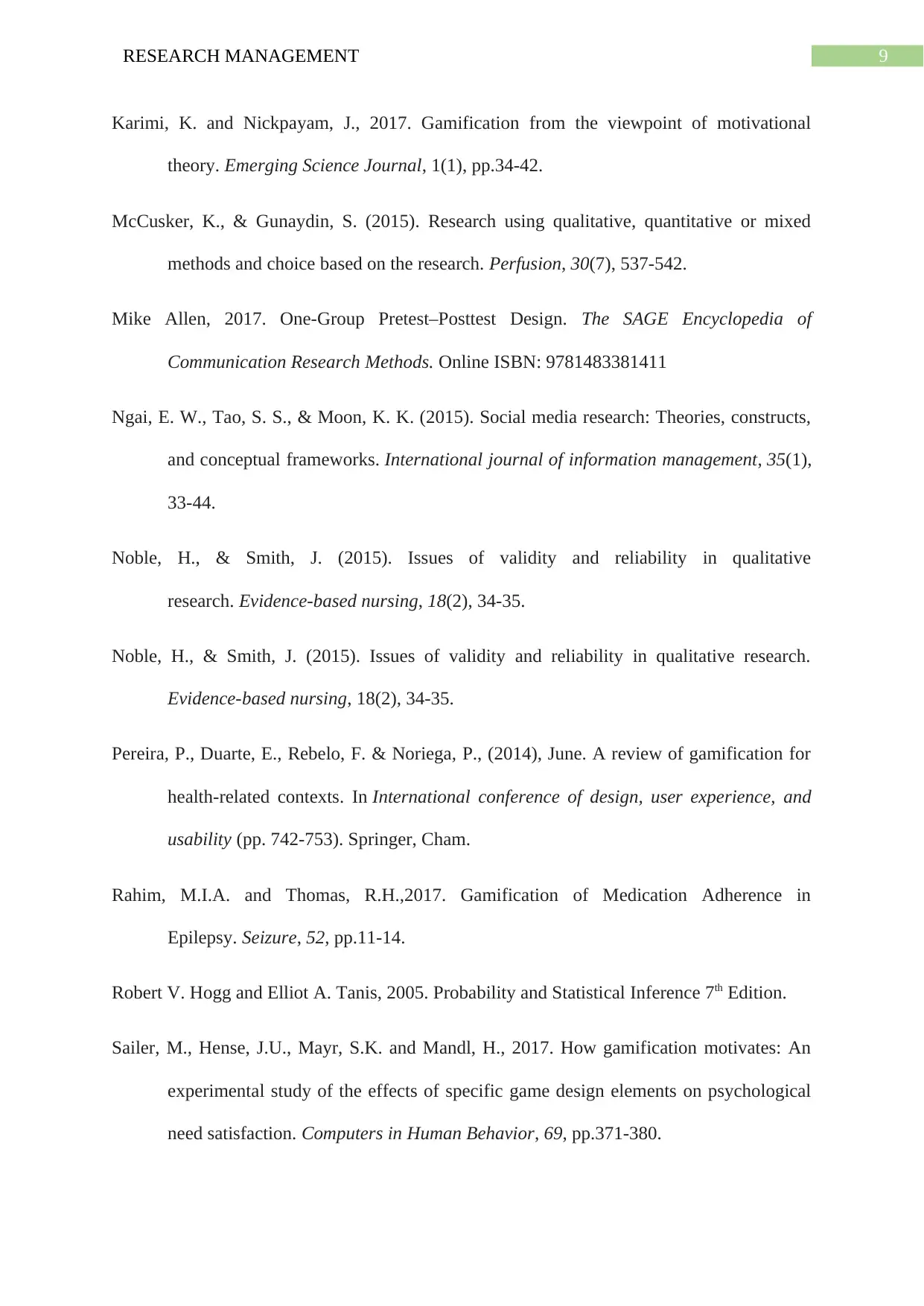
9RESEARCH MANAGEMENT
Karimi, K. and Nickpayam, J., 2017. Gamification from the viewpoint of motivational
theory. Emerging Science Journal, 1(1), pp.34-42.
McCusker, K., & Gunaydin, S. (2015). Research using qualitative, quantitative or mixed
methods and choice based on the research. Perfusion, 30(7), 537-542.
Mike Allen, 2017. One-Group Pretest–Posttest Design. The SAGE Encyclopedia of
Communication Research Methods. Online ISBN: 9781483381411
Ngai, E. W., Tao, S. S., & Moon, K. K. (2015). Social media research: Theories, constructs,
and conceptual frameworks. International journal of information management, 35(1),
33-44.
Noble, H., & Smith, J. (2015). Issues of validity and reliability in qualitative
research. Evidence-based nursing, 18(2), 34-35.
Noble, H., & Smith, J. (2015). Issues of validity and reliability in qualitative research.
Evidence-based nursing, 18(2), 34-35.
Pereira, P., Duarte, E., Rebelo, F. & Noriega, P., (2014), June. A review of gamification for
health-related contexts. In International conference of design, user experience, and
usability (pp. 742-753). Springer, Cham.
Rahim, M.I.A. and Thomas, R.H.,2017. Gamification of Medication Adherence in
Epilepsy. Seizure, 52, pp.11-14.
Robert V. Hogg and Elliot A. Tanis, 2005. Probability and Statistical Inference 7th Edition.
Sailer, M., Hense, J.U., Mayr, S.K. and Mandl, H., 2017. How gamification motivates: An
experimental study of the effects of specific game design elements on psychological
need satisfaction. Computers in Human Behavior, 69, pp.371-380.
Karimi, K. and Nickpayam, J., 2017. Gamification from the viewpoint of motivational
theory. Emerging Science Journal, 1(1), pp.34-42.
McCusker, K., & Gunaydin, S. (2015). Research using qualitative, quantitative or mixed
methods and choice based on the research. Perfusion, 30(7), 537-542.
Mike Allen, 2017. One-Group Pretest–Posttest Design. The SAGE Encyclopedia of
Communication Research Methods. Online ISBN: 9781483381411
Ngai, E. W., Tao, S. S., & Moon, K. K. (2015). Social media research: Theories, constructs,
and conceptual frameworks. International journal of information management, 35(1),
33-44.
Noble, H., & Smith, J. (2015). Issues of validity and reliability in qualitative
research. Evidence-based nursing, 18(2), 34-35.
Noble, H., & Smith, J. (2015). Issues of validity and reliability in qualitative research.
Evidence-based nursing, 18(2), 34-35.
Pereira, P., Duarte, E., Rebelo, F. & Noriega, P., (2014), June. A review of gamification for
health-related contexts. In International conference of design, user experience, and
usability (pp. 742-753). Springer, Cham.
Rahim, M.I.A. and Thomas, R.H.,2017. Gamification of Medication Adherence in
Epilepsy. Seizure, 52, pp.11-14.
Robert V. Hogg and Elliot A. Tanis, 2005. Probability and Statistical Inference 7th Edition.
Sailer, M., Hense, J.U., Mayr, S.K. and Mandl, H., 2017. How gamification motivates: An
experimental study of the effects of specific game design elements on psychological
need satisfaction. Computers in Human Behavior, 69, pp.371-380.
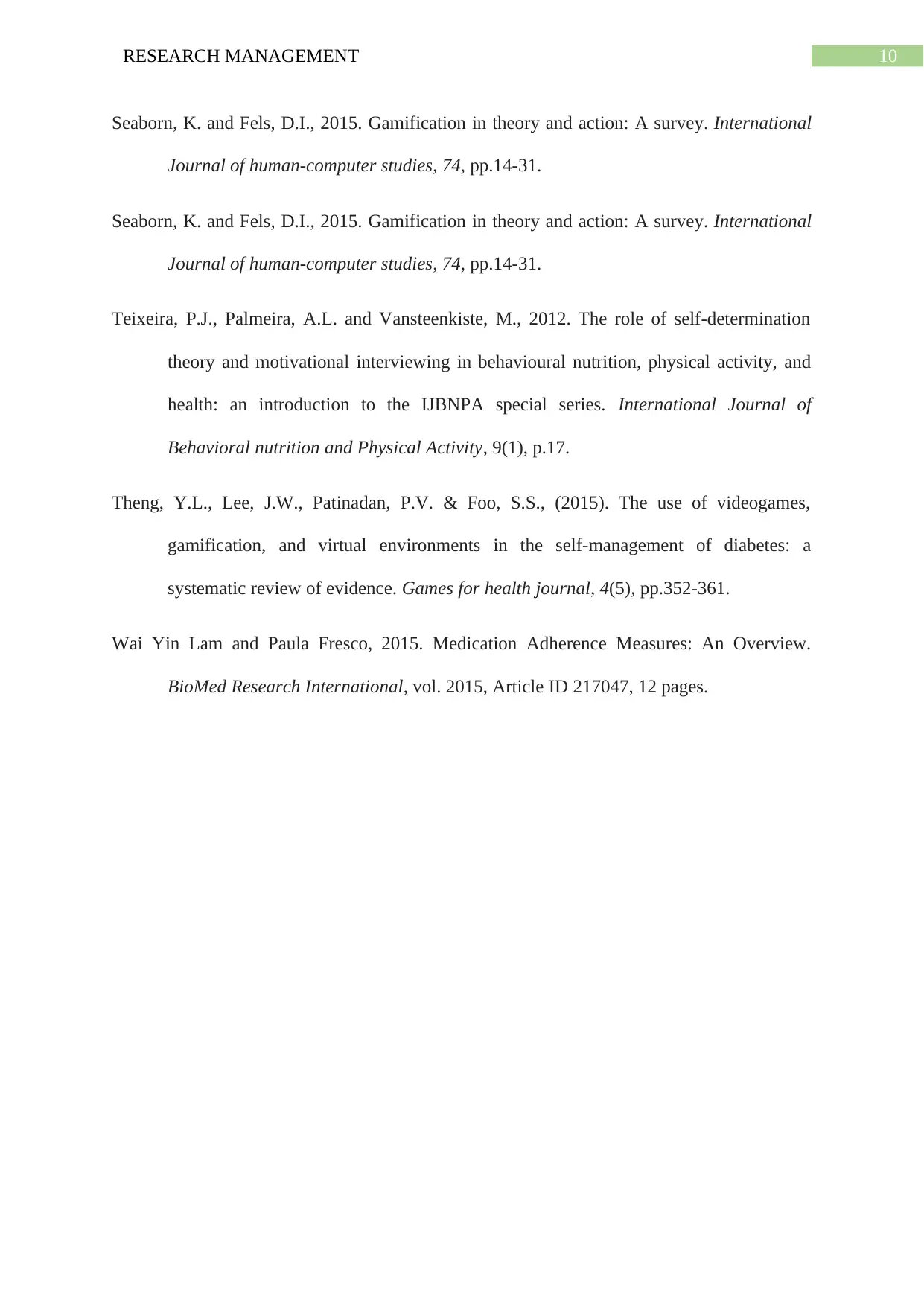
10RESEARCH MANAGEMENT
Seaborn, K. and Fels, D.I., 2015. Gamification in theory and action: A survey. International
Journal of human-computer studies, 74, pp.14-31.
Seaborn, K. and Fels, D.I., 2015. Gamification in theory and action: A survey. International
Journal of human-computer studies, 74, pp.14-31.
Teixeira, P.J., Palmeira, A.L. and Vansteenkiste, M., 2012. The role of self-determination
theory and motivational interviewing in behavioural nutrition, physical activity, and
health: an introduction to the IJBNPA special series. International Journal of
Behavioral nutrition and Physical Activity, 9(1), p.17.
Theng, Y.L., Lee, J.W., Patinadan, P.V. & Foo, S.S., (2015). The use of videogames,
gamification, and virtual environments in the self-management of diabetes: a
systematic review of evidence. Games for health journal, 4(5), pp.352-361.
Wai Yin Lam and Paula Fresco, 2015. Medication Adherence Measures: An Overview.
BioMed Research International, vol. 2015, Article ID 217047, 12 pages.
Seaborn, K. and Fels, D.I., 2015. Gamification in theory and action: A survey. International
Journal of human-computer studies, 74, pp.14-31.
Seaborn, K. and Fels, D.I., 2015. Gamification in theory and action: A survey. International
Journal of human-computer studies, 74, pp.14-31.
Teixeira, P.J., Palmeira, A.L. and Vansteenkiste, M., 2012. The role of self-determination
theory and motivational interviewing in behavioural nutrition, physical activity, and
health: an introduction to the IJBNPA special series. International Journal of
Behavioral nutrition and Physical Activity, 9(1), p.17.
Theng, Y.L., Lee, J.W., Patinadan, P.V. & Foo, S.S., (2015). The use of videogames,
gamification, and virtual environments in the self-management of diabetes: a
systematic review of evidence. Games for health journal, 4(5), pp.352-361.
Wai Yin Lam and Paula Fresco, 2015. Medication Adherence Measures: An Overview.
BioMed Research International, vol. 2015, Article ID 217047, 12 pages.
Secure Best Marks with AI Grader
Need help grading? Try our AI Grader for instant feedback on your assignments.

11RESEARCH MANAGEMENT
1 out of 11
Related Documents
Your All-in-One AI-Powered Toolkit for Academic Success.
+13062052269
info@desklib.com
Available 24*7 on WhatsApp / Email
![[object Object]](/_next/static/media/star-bottom.7253800d.svg)
Unlock your academic potential
© 2024 | Zucol Services PVT LTD | All rights reserved.




